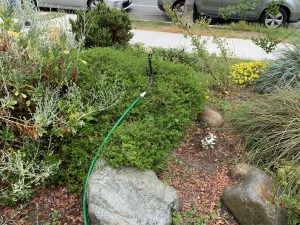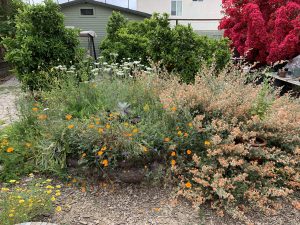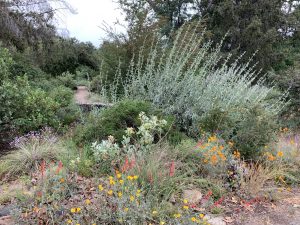Spring 2019 has been the best season of the best year for the best bloom in a long time! Many plants are still going off and it seems they just won’t quit. Their flowering time can be extended, and summer bloomers can be welcomed into the show as we take certain steps and perform a few simple tasks in this key transitional month, May. This is a time to be active in your garden so dear gardener, read on…
We got 20-22+” of rain last season. Since most of that came by way of rain showers with intermittent periods of pleasant sunny weather, the soil in our gardens’ root zone has perfect moisture in the root zone, 12-18” deep. The key this month will be to lock valuable moisture into place. The roots will stay happy down there where cool temperatures will promote good health and no disease.
As previously proposed last year, here is our Six Season Calendar for the California Natural Garden. Note: Both May and September are transition months.
Pre-Summer – May – Bye bye cool and moist, hello hot and dry, transition month.
Summer – June, July, August – enjoy the long days, judicious watering, summer bloom.
Pre-Fall – September – Bye bye hot and dry, hello cool and moist, transition month.
Fall – October, November – many garden tasks, planting season begins, fall flowers.
Winter – December, January – enjoy the short days, migratory birds, bundle up, pray for rain.
Spring – February, March, April – enjoy abundant flowers, birds, butterflies, life!, good planting season.
Watering
Days are noticeably longer and with summer solstice only seven weeks away (day length increases about 1 minute per day), we are about an hour short of the longest day. With more light, and increased heat, the plants will need water both for growing and cooling. This year most plants have ample new growth which started coming on 4-6 weeks ago.
You can give your garden a deep soak this month. Wait for a cool spell, water 2-3 days in a row with low volume sprinklers, applying the equivalent of approximately 1” rainfall. This irrigation water will penetrate into the deep cool root zone to keep the soil down there consistently moist.
If we get any hot weather this month, you can provide refreshing sprinkles late in the day to cool down the leaves and the surface of the soil.

Related to Watering
Due to exposure, soil type, planting time, and changing sun patterns, individual plants and certain sections of your garden may dry out before the entire area does. Watch for this, and deal with it as needed by setting a hose at a trickle for several hours, placing a hose-end mini sprinkler in the dry spot, or thoroughly watering by hand. We call this activity “spot watering.” Very important during this transition month, especially as the sun’s position in the sky changes.
Pruning
Some of the most effective pruning at this time will be tip pruning or “pinching.” Please see this link from mid-April 2019.
Note:A as a general rule, manzanitas need no pruning. If branches are encroaching on a walkway or patio, best to remove the whole branch rather than to continually hedge the plant. You can also prune lower branches to expose the twisted dark red branches. If you do any tip pruning at all, cut only the very fine terminal bud (1/4-1/2” tip) with your fingernails, to encourage the side shoots. Ceanothus can be headed back and shaped when they finish flowering, before they start to set seed, typically mid-May. Always sanitize your shears between cuts with 10% bleach solution.
Other natives can be safely pruned now in order to get them ready for summer. Natural shapes are best, no hard edges, and please, no globescubestrianglessquares, unless your garden design depends on whimsical and technically ugly pruning. We see too much of this abominable practice in the commercial landscape all around. Let’s give our plants a chance to look “natural.”
Weeding
If you still have a weed problem now, it is definitely a bigger problem than it was a month ago. Don’t delay. Grub those weeds out with a hoe, pull them or at least cut off the flower heads before they set seed, so you can completely eradicate them at a more convenient time later.
Mulching/Top dress
The classic advantages of organic material (mulch/top dress) on the soil surface include cooling the soil, conserving soil moisture, deterring weeds, and providing a uniform clean look. The unfortunate disadvantages include importing new toxins, diseases, and weed seeds into the garden, making water management difficult, harboring argentine ant colonies, and excluding native ground-nesting pollinator bee species. The key is to apply good mulch at the right time. Or not. Good mulch and bad mulch can be compared to good wine and cheap vinegar.
As a general rule, small plants and new gardens should have fine textured (1/2”) bark mulch, and established shrubs and older gardens will do well with coarse (3/4”+) bark. Clean, organic, sourced from a single species if possible, no eucalyptus, no palm, no grass clippings, no manures, pine is not advisable… you can see that choosing the right mulch is important. And it can be expensive. In many California native gardens, mineral top dress, decomposed granite and/or small pebbles/rocks in drifts can be quite effective and very attractive.
The real goal is to cultivate healthy plants that will shade their own space with their own branches, and as their leaves drop, provide natural mulch for cooling, moisture retention and weed control. Like abusive pruning, indiscriminate “mulching” has become a serious problem in commercial landscapes, and not an example for us to follow. In our natural gardens, we know there is a better way.
Feeding
We recommended feeding in the March post. You can give your garden its last boost until fall by spreading a light application of (dry, from bags) all-purpose organic plant food. Lightly scratch it into the top 1/2” of soil/mulch and perform your deep soak. Follow label instructions for rates.
Troubleshooting – Varmints, Pests and Diseases
Prevention, prevention, prevention. Water deeply now to avoid summer root disease later. While you are tip pruning and pinching, inspect the branches for plant pests. Create a healthy ecosystem with beneficials everywhere so you have a natural balance. If ants and snails are invading from your neighbor’s super saturated landscape, convince them (the neighbors) to go native. Write me with your garden questions at the address below.
Insect problems with manzanita or ceanothus? See January 2019 Troubleshooting.

Annual Wildflowers
Enjoy the flowers from the seed you planted last fall. And collect seeds from your own plants as today’s flowers fade. Throw it all in a paper bag marked “Wildflowers” or carefully categorize each species in separate containers. By the way, how you do this will speak volumes about your personality type.
Adding New Plants
Soils are still cool and we have perfect weather ahead. May is a great time to plant. Come see us soon. The nursery has never looked better, and I mean that.

Engage
Dear gardener, there is a movement afoot for an honest return to the type of garden that will offer us experience in the moment, good memories of the past, and anticipation of things to come. All around, people are realizing that a garden is a living entity that will engage us in a reciprocal relationship for the health and well being of both parties. Stop by the nursery soon and tell us your experiences. Share your photos on social media, and speak out for nature’s healing power so this movement will continue to grow… like our plants in May… like our gardens in our lifetime.
From the Garden,
Mike Evans
Questions? Help is just one call or one email away. Call (949) 728-0685 or email (with pictures if you like) our special helpline: gardenhelp@californianativeplants.com
To get our monthly updates please sign up for our eNewsletter at this link here.